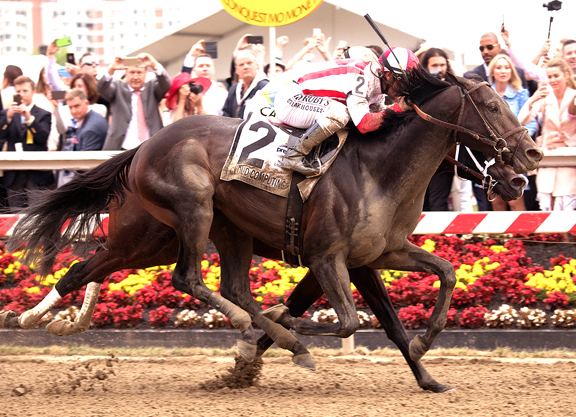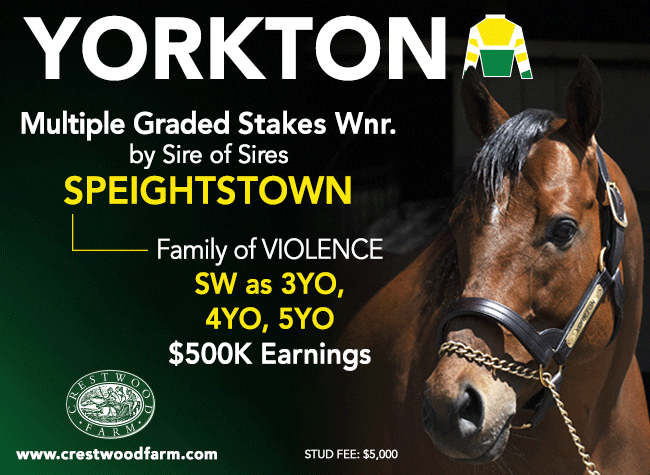By Bill Oppenheim
WinStar's Bodemeister is the sire of Always Dreaming, winner of the GI Kentucky Derby, which was worth almost $2.4 million, and is now the leading North American second-crop sire, both by 2017 progeny earnings (click here), and by cumulative progeny earnings for North American second-crop sires (click here). One Triple Crown race, one win by a 3-year-old from the first crop of a 'second-crop' sire. Always Dreaming couldn't double up in the $1.5-million GI Preakness S., so in stepped Cloud Computing, from the first crop of 3-year-olds by another second-crop sire, Hill 'n' Dale's Maclean's Music, who thus moves into second place on the YTD North American second-crop sire list, and also moves into fourth place on the cumulative list–though less than $10,000 separates the two-three-four on that list. The two-three as of yesterday were last year's top two North American Freshman sires, Darby Dan's Dialed In and Lane's End's Union Rags.
Bodemeister won the 2012 GI Arkansas Derby and ran second in the Kentucky Derby and the Preakness; even civilians may have heard of him. Dialed In won the GI Florida Derby in 2011, while Union Rags won the GI Champagne S. as a 2-year-old and the GI Belmont S. in 2012 after I'll Have Another was injured pre-race and in the absence of Bodemeister, too. But Maclean's Music; who is he?
Maclean's Music is by Distorted Humor out of the Grade II-winning sprinting filly Forest Music, by Unbridled's Song out of Defer, by Gone West. He was bred and raced by Stonestreet, and trained by Steve Asmussen, and won his one and only start, a 6-furlong maiden race at Santa Anita in March, 2011, clocking a time of 1:07:2/5 and registering a Beyer figure of 114–the highest Beyer figure ever recorded by a first-time starter. Unfortunately, he never ran again, though he didn't stand as a 4-year-old in 2012, and stood his first season, for $6,500, at Hill 'n' Dale in 2013. John Sikura has a very good record at making sires at Hill 'n' Dale–think Medaglia d'Oro and Candy Ride, for two–and Maclean's Music was priced right for breeders to take a shot that he would transmit his brilliance. In that regard, one thing we've noticed about sires who overcome the odds is that a good many of them seem to be out of good racemares, and believe me, if you don't remember: Forest Music was a rocket.
With 82 registered foals in his first crop (73 named at the end of 2016), 38 yearlings by Maclean's Music averaged $41,463 at the 2015 yearling sales; Cloud Computing, bought by bloodstock agent Mike Ryan (also co-breeder of Always Dreaming) from Keeneland September Book 3 for $200,000, was the most expensive yearling from the sire's first crop. Maclean's Music's second and third crops (this year's yearlings) number about 65 foals each, and he covered 90 mares last year for foals of 2017. So he's got respectable-sized crops, but like virtually all four-figure stud fee sires in Kentucky the last few years, they're more likely to cover 80 mares than 180. He made a good start in 2016, leading all North American freshman sires in two categories, with 20 winners, and seven Black-Type Horses (two were BT winners), and finishing eighth on the TDN North American Freshman Sire List (click here) by progeny earnings. His stud fee got a little bump up, to $8,500, for 2017.
Cloud Computing, however, was not one of Maclean's Music's 40 starters or 20 winners in 2016. He broke his maiden on Aqueduct's inner track at six furlongs in February, stamped himself a horse to watch when running second to J Boys Echo in just his second start, the GIII Gotham S. in March, then was third behind Irish War Cry and Battalion Runner in the GII Wood Memorial S. in early April. As has been well documented by Bill Finley in Sunday's TDN (click here), Chad Brown made the decision not to throw him to the wolves in the Derby, and certainly the six-week gap after three quick races paid big dividends as Cloud Computing came and nailed Classic Empire near the wire at Pimlico for popular owners Seth Klarman (Klaravich Stables) and William H. Lawrence. In the process, he guaranteed Maclean's Music a bigger book of better mares at a higher stud fee in 2018.
Like Always Dreaming in the Derby, Cloud Computing returned a Beyer of 102 in the Preakness. Those figures are on the low side, though it's not surprising as going into the Derby the top two-turn Grade I/II 3-year-old figure was Irish War Cry's 101 in the Wood, and Classic Empire had run 102 when wrapping up last year's juvenile championship in the GI Breeders' Cup Juvenile. In fact, as the attached table illustrates, the average winning Beyers for all three Triple Crown races have declined by six points and change in the last nine years (2009-2017) compared to the first nine years of the new millenium (2000-2008). Specifically: the 2000-2008 average winning Kentucky Derby Beyer was 109.3; in the last nine years, 2009-2017, the average winning Beyer is 102.7 (-6.6). In the Preakness, the average winning Beyer has declined from 110.7 to 104.3 (-6.4); and in the Belmont (not including 2017, obviously) the decline has been from 105.0 to 99.0 (-6.0). In fact, American Pharoah's 105 when he completed the 2015 Triple Crown was the only time the winning Beyer in the Belmont has been above 100 since 2007; given that statistic, it's definitely true that America is not breeding 12-furlong horses any more.
Why there should be this six-point decline coinciding with the 2008 world financial crash is mysterious; it could just be coincidence, and that the timing of the decline is just the manifestation of declines that have been coming for a long time–although the fact the North America foal crop has declined by 40% since then could also be a big factor. But it hasn't meant America has not seen seriously top-class Beyer 120+ performances from 3-year-olds–we have. American Pharoah, in his final race as a 3-year-old, ran a Beyer 120 to win the 2015 GI Breeders' Cup Classic–a 15-point improvement from his best winning figure in the Triple Crown races. And of course last year Arrogate, who didn't contest any of the Triple Crown races, appeared in the second half of the season to run a 122 in the GI Travers S., followed by another 120 when defeating California Chrome in the 2016 GI Breeders' Cup Classic. A lot of horses do improve in the second half of their 3-year-old year. So perhaps in this regard the news is not as bad it looks at first glance; nonetheless, this six-point decline is widespread, and looks significant. The methodology employed hasn't changed, so the declines are real, even if we don't really understand why they have occurred or what they predict for the future. But I guess it's also fair to say the fact that the last two winners of the Breeders' Cup Classic have been 3-year-olds who both ran Beyer 120 to win does mean there are very good 3-year-olds; they just might be improving, or appearing, later. Contact Bill Oppenheim at [email protected] (cc ).
Not a subscriber? Click here to sign up for the daily PDF or alerts.






